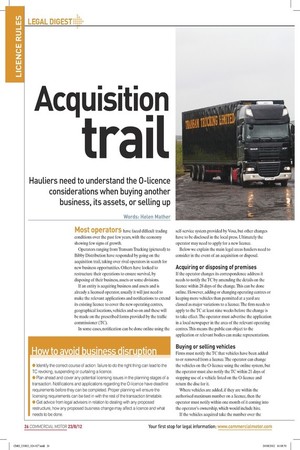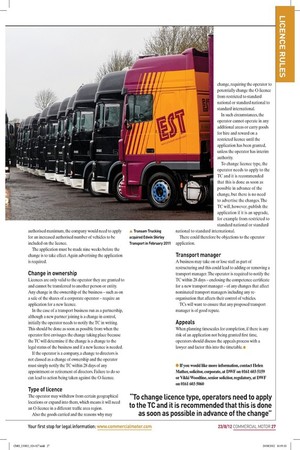Acquisition
Page 17

Page 18

If you've noticed an error in this article please click here to report it so we can fix it.
trail
Hauliers need to understand the O-licence considerations when buying another business, its assets, or selling up
Words: Helen Mather
Most operators have faced difficult trading conditions over the past few years, with the economy showing few signs of growth.
Operators ranging from Transam Trucking (pictured) to Bibby Distribution have responded by going on the acquisition trail, taking over rival operators in search for new business opportunities. Others have looked to restructure their operations to ensure survival, by disposing of their business, assets or some divisions.
If an entity is acquiring business and assets and is already a licensed operator, usually it will just need to make the relevant applications and notifications to extend its existing licence to cover the new operating centres, geographical locations, vehicles and so on and these will be made on the prescribed forms provided by the traffic commissioner (TC).
In some cases, notification can be done online using the self-service system provided by Vosa, but other changes have to be disclosed in the local press. Ultimately the operator may need to apply for a new licence.
Below we explain the main legal areas hauliers need to consider in the event of an acquisition or disposal.
Acquiring or disposing of premises
If the operator changes its correspondence address it needs to notify the TC by amending the details on the licence within 28 days of the change. This can be done online. However, adding or changing operating centres or keeping more vehicles than permitted at a yard are classed as major variations to a licence. The firm needs to apply to the TC at least nine weeks before the change is to take effect. The operator must advertise the application in a local newspaper in the area of the relevant operating centres. This means the public can object to the application or relevant bodies can make representations.
Buying or selling vehicles
Firms must notify the TC that vehicles have been added to or removed from a licence. The operator can change the vehicles on the O-licence using the online system, but the operator must also notify the TC within 21 days of stopping use of a vehicle listed on the O-licence and return the disc for it.
Where vehicles are added, if they are within the authorised maximum number on a licence, then the operator must notify within one month of it coming into the operator’s ownership, which would include hire.
If the vehicles acquired take the number over the authorised maximum, the company would need to apply for an increased authorised number of vehicles to be included on the licence.
The application must be made nine weeks before the change is to take effect. Again advertising the application is required.
Change in ownership
Licences are only valid to the operator they are granted to and cannot be transferred to another person or entity. Any change in the ownership of the business – such as on a sale of the shares of a corporate operator – require an application for a new licence.
In the case of a transport business run as a partnership, although a new partner joining is a change in control, initially the operator needs to notify the TC in writing. This should be done as soon as possible from when the operator first envisages the change taking place because the TC will determine if the change is a change to the legal status of the business and if a new licence is needed.
If the operator is a company, a change to directors is not classed as a change of ownership and the operator must simply notify the TC within 28 days of any appointment or retirement of directors. Failure to do so can lead to action being taken against the O-licence.
Type of licence
The operator may withdraw from certain geographical locations or expand into them, which means it will need an O-licence in a different traffic area region.
Also the goods carried and the reasons why may change, requiring the operator to potentially change the O-licence from restricted to standard national or standard national to standard international.
In such circumstances, the operator cannot operate in any additional areas or carry goods for hire and reward on a restricted licence until the application has been granted, unless the operator has interim authority.
To change licence type, the operator needs to apply to the TC and it is recommended that this is done as soon as possible in advance of the change, but there is no need to advertise the changes. The TC will, however, publish the application if it is an upgrade, for example from restricted to standard national or standard national to standard international.
There could therefore be objections to the operator application.
Transport manager
A business may take on or lose staff as part of restructuring and this could lead to adding or removing a transport manager. The operator is required to notify the TC within 28 days – enclosing the competence certificate for a new transport manager – of any changes that affect nominated transport managers including any reorganisation that affects their control of vehicles.
TCs will want to ensure that any proposed transport manager is of good repute.
Appeals
When planning timescales for completion, if there is any risk of an application not being granted first time, operators should discuss the appeals process with a lawyer and factor this into the timetable. ■ ● If you would like more information, contact Helen Mather, solicitor, corporate, at DWF on 0161 603 5159 or Vikki Woodfine, senior solicitor, regulatory, at DWF on 0161 603 5060
How to avoid business disruption
● Identify the correct course of action: failure to do the right thing can lead to the TC revoking, suspending or curtailing a licence.
● Plan ahead and cover any potential licensing issues in the planning stages of a transaction. Notifications and applications regarding the O-licence have deadline requirements before they can be completed. Proper planning will ensure the licensing requirements can be tied in with the rest of the transaction timetable.
● Get advice from legal advisers in relation to dealing with any proposed restructure, how any proposed business change may affect a licence and what needs to be done.








































